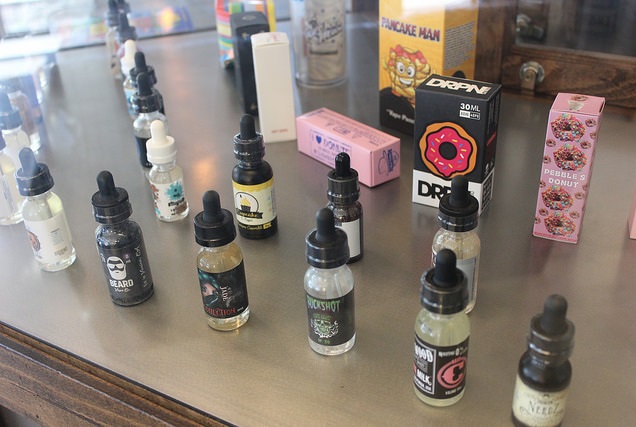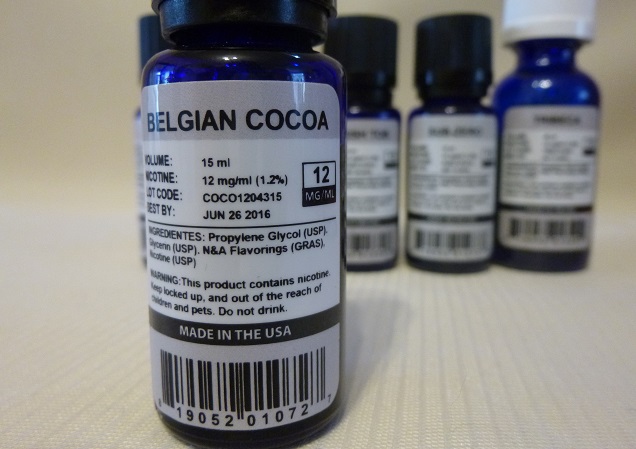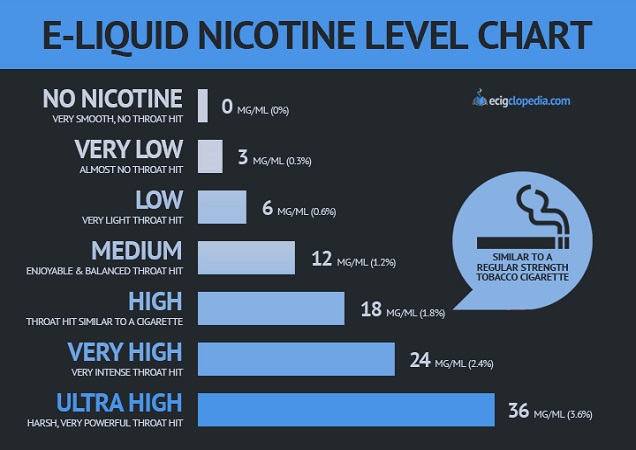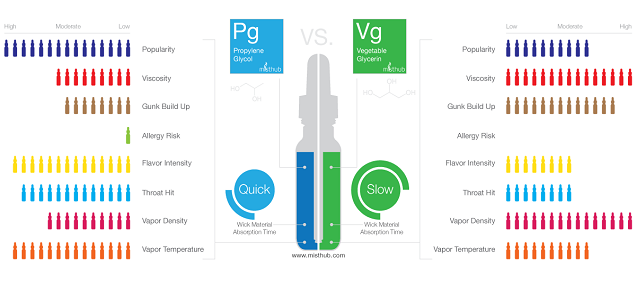
When it comes to buying e-juice, there are two things you need know about: PG/VG ratios and nicotine levels. The biggest concern for just-switching smokers is (understandably) the amount of nicotine you’re getting in your e-liquid, but finding the right balance of PG and VG for your needs is equally important, because both have a big role to play in how satisfying you find vaping.
So how do you find the right PG/VG ratio for your needs? Which nicotine level do you need to ensure you’ll find vaping satisfying? Here’s everything you need to know:
Nicotine Levels in E-Juice – A Primer

Before discussing which nicotine level is right for you, it’s a good idea to have a look at how nicotine levels in e-juice work and what they mean.
The most common way of expressing nicotine levels in e-liquid is through milligrams (mg) of nicotine per milliliter (ml) of e-liquid, so they’re expressed as a number followed by mg/ml (although the /ml is often omitted). This means that an 18 mg/ml e-liquid has 18 mg of nicotine for every ml of e-juice in the bottle, so a 15 ml bottle of it contains 18 × 15 = 270 mg of nicotine in total.
Some companies express the nicotine levels as a percentage, which simply tells you what proportion of the e-juice is liquid nicotine. As it works out, the percentage value is basically the same as the mg/ml value, except divided by 10. So an 18 mg/ml e-liquid is also 1.8 % nicotine, and a 6 mg/ml e-liquid is 0.6 % nicotine.
The most commonly-used nicotine levels are:
- 0 mg/ml (0 %)
- 3 mg/ml (0.3 %)
- 6 mg/ml (0.6 %)
- 12 mg/ml (1.2 %)
- 18 mg/ml (1.8 %)
- 24 mg/ml (2.4 %)
In some cases, extra levels such as 1.5 mg/ml (0.15 %) or 36 mg/ml (3.6 %) will be offered too, but these aren't very common.
If you’re familiar with the amounts of nicotine normally listed on the side of cigarette packs, these figures might seem awfully high, but there is an important difference: the values on the side of a pack of cigarettes show the yield of nicotine. In other words, they show the amount of nicotine you actually get when you smoke, rather than the amount present in the actual tobacco itself, which is much higher. The e-liquid nicotine levels are the amount in the juice, and so can’t be simply compared with the values listed on a pack of cigarettes.
How Much Nicotine Do I Need in My E-Liquid?

So what’s the right nicotine level for your needs? Well, the decision is fairly straightforward, but there is a certain element of trial and error involved. The challenge is striking the balance between two things: the need for a substantial amount of nicotine to replace cigarettes and the harshness of high nicotine e-liquids.
In general, high nicotine juices do a bit more of a number on the back of your throat that lower-nicotine ones. For smokers looking for the same type of “throat hit” you get with cigarettes, this can actually be a good thing, but many will find that it makes vaping pretty unpleasant. Your PG/VG ratio has a big part to play in the throat hit, though, so there are ways to get the best of both worlds.
The other issue with higher-nicotine liquids is getting too much nicotine: this might not be a big issue when you first make the switch, but 24 mg/ml e-liquids can take you to the point of nausea a little too quickly, especially if you’re using a sub-ohm tank or other modern atomizer.
With that all said, the core advice is simple: 18 or 24 mg/ml nicotine e-liquids are ideal for just-switching smokers. The general guideline for pack-a-day smokers is to opt for 18 mg/ml e-juice when you’re just starting out, but heavier smokers or people who find 18 mg/ml isn’t satisfying enough should increase to 24 mg/ml.
In the unlikely event that you find 18 mg/ml too harsh or get too much nicotine, then 12 mg/ml is probably the lowest you can realistically go when you’re first making the switch if you still want a satisfying vape.
We’d advise starting on 18 mg/ml, but picking up a 24 mg/ml bottle of juice (or pack of cartridges, for cigalike users) is a good precaution, just in case 18 mg/ml doesn’t satisfy you. One exception is for very heavy smokers – of 30 or so per day – who may be better off going right to 24 mg/ml and getting a bottle of 18 mg/ml in case you run into issues.
Modern sub-ohm tanks and rebuildable atomizers are generally more efficient at getting you the nicotine you're looking for, though, so if you're using a better atomizer, you might need to reduce your nicotine level to compensate. Most beginners won't use rebuildables, but if you've got a sub-ohm tank, even pack-a-day smokers might find 18 mg/ml provides too much nicotine when coupled with the substantial vapor production, so you may need to drop down to 12 mg/ml or possibly even lower.
PG and VG in E-Cigarettes – A Primer

The remaining consideration is PG and VG, the commonly-used acronyms for propylene glycol and vegetable glycerin. These two chemicals basically serve the same purpose in e-liquid: they are carriers for the nicotine and flavorings, and they are easy to turn into a vapor.
From a vaper’s point of view, the core differences between them are the throat hit, the flavor, the vapor production and the viscosity.
PG is a thinner liquid, carries flavor a little bit better and produces a stronger throat hit compared to VG. This means higher-PG juices are well-suited to pretty much any atomizer, will maximize the flavor from your e-juice and will give you more of a smoke-like feeling at the back of your throat as you inhale.
VG, in comparison, is a more viscous liquid, has a much milder throat hit and produces denser clouds of vapor. This means you’ll need a tank with efficient wicking (such as a sub ohm tank) to get the most out of a higher-VG e-liquid, but that it’s a great choice for anybody who finds vaping higher-PG juices too harsh on the throat. Also, if you want big clouds, VG is your friend.
Which PG/VG Ratio is Right for Me?
PG/VG ratios are an important consideration, but it should be stressed that some variation in PG/VG ratios isn’t really an issue. Most liquids these days have around a 50/50 ratio, which gives some of the benefits of both and minimizes their respective downsides.
For most vapers, as long as it’s close to this, you’ll be satisfied – anything from 70/30 (PG to VG) to 30/70 is absolutely fine. If you want a slightly stronger throat hit, or want a thinner e-liquid to improve wicking and avoid “dry hits,” then opt for one with the balance tipped in favor of PG. If you want a smoother throat hit or more vapor, slightly higher VG ratios are great.
The only juices to consider carefully are ones with more than 70 % of one ingredient. With 80 % PG or more, the juice will be thin (and carry flavor a little better than VG-based juices), but the throat hit – especially for a higher-nicotine juice – might make vaping unpleasant. Some people are also sensitive to PG, so higher-PG juices would be very unpleasant to vape for that reason.
For higher-VG juices (again, classing this as higher than 80 % VG), the viscosity will cause a problem with many clearomizers and tanks, and the throat hit will be severely lacking. You’ll get a thicker cloud of vapor, but this is less important for just-switching smokers, who will undoubtedly miss the throat hit from PG. However, higher-VG juices are great for anybody who finds normal juices too harsh on their throat, and may enable you to enjoy a higher nicotine level than you’d be able to otherwise.
Additionally, the better vapor production from sub-ohm tanks means that higher-PG liquids can be quite harsh on your throat if you're using one. So if you have a sub-ohm tank or rebuildable, it's worth considering higher-VG blends for that reason too. Starting at around 50/50 and adjusting as needed is still the best approach, though.
So the take-away message here is very simple: most e-juices have a roughly even mixture of PG and VG, and will be suitable for most vapers. If you have a preference for vapor production or throat hit, you can shift the balance accordingly. The only time to go to the extreme ends of the spectrum is if you’ve tried ordinary PG/VG ratios and you have a strong preference for one or the other.
Experiment With Different Options, But Norms Exist for a Reason
The lesson from this is that you may need to experiment a little to find the ideal PG/VG ratio and nicotine level for your needs, but there are good reasons for the common recommendations when it comes to nicotine and PG/VG ratios. If you stick close to the norm, you’ll probably find something to suit your preferences, but don’t be afraid to try something else out if you’re unsatisfied with your early experiences as a vaper.

